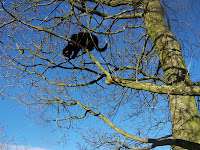
This is me up a tree doing my leopard act. I want to grow up to be a black panther like Bagheera. I used to think I could catch birds this way. Nowadays I just do it to amuse and alarm Celia. She stands underneath saying "Pleeeeease George, come down." She remembers when I climbed up as a tiny kitten one frosty December day, and was only rescued when a passing Human Hero got off his tractor, climbed up 30 feet, grabbed me and climbed down using only one hand.
My colour - black is called melanistic by scientists - may give me superior health and survival skills. Stephen O Brien (see earlier blog on 7/2/07) and Eduardo Eizirik, of the Cat Genome Project at the US National Cancer Institute have tracked down the melanism gene in 11 of the cat species. I have it in common with black panthers (melanistic leopards) and jaguars and jaguarundis. "Perhaps the selective pressure that allowed these mutations to survive in cats may not be camouflage. Perhaps the mutations cause resistance of the cats to bugs," O'Brien told Reuters in 2004.
Interestingly many stray cats are black or black and white. It is theorised that this happens because humans dislike black and therefore are more likely to adopt "pretty' strays - tabbies or tabbies and white like my elderly companion William. They just leave the black kittens to grow up wild and hungry. (Honestly, there is so much to dislike about humans. Colour prejudice is one of their more disagreeable traits.) And the black cats stay longer in rescue establishments because nobody wants them.
But maybe there are more of us on the streets partly because we survive better. I ought to try to contact the Italians who are holding Black Cat Day in November (see blog 8/27/07) to tell them this. We black cats are lucky not unlucky. Black power rules in catland.

Well george, this is all very interesting. My brother and I are very pleased to be in a household where black cats are the favourite. Even the grandchildren are highly appreciative of them - little Lily says proudly that her cat 'Flea', who is little more than a kitten in my view, (and completely black) has already caught 3 birds, 1 rat, 2 mice,and a rabbit. This is yet another example of the highly developed hunting instincts of the black cat.
ReplyDeleteyours Opus 2
I am very impressed with your ability to climb trees! I'm an indoor-only cat, because without any fur, it's not safe for me to be outdoors.
ReplyDelete